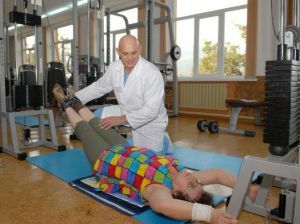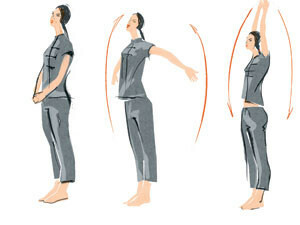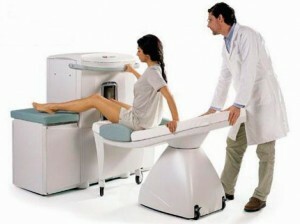 Heel spurs are border bone growths in the form of a wedge or spine on the plantar side of the calcaneus or at the attachment point of the Achilles tendon. Most often, the disease develops in overweight women aged 40 to 60 years.
Heel spurs are border bone growths in the form of a wedge or spine on the plantar side of the calcaneus or at the attachment point of the Achilles tendon. Most often, the disease develops in overweight women aged 40 to 60 years.
The main symptom of the appearance of the heel spur is pain in the heel. Pain occurs when walking. Over time, pain occurs when standing and any support on the heel. The pain is acute and burning, the patients compare it with "nail feeling in the heel".
The intensity of the sensations depends on the proximity of the built-up edge to the nerve endings, the greatest discomfort occurs in the morning, after the feet are at rest, and the micro-ruptures in the fascia are reduced.
A gradual change in the gait of the patient is possible, due to the need to relieve the load from the heel. In the presence of heel spurs on both lower limbs, patients often require crutches and walking sticks.
Often, external changes are not observed. In some cases, there is a slight swelling of the heel area.
For the diagnosis is sufficient to conduct a radiography. At the initial stages in the picture, a slight elevation above the bone surface( several millimeters) will be seen. In the case of a prolonged course of the disease, the size of the osteophyte may be more than one centimeter.
Contents of the article
- X-ray treatment
- X-ray therapy methods used
- Description of the procedure
- Techniques advantages
- Expected result
- Contraindications and cautions
Factors provocateurs
Heel spurs arise for the following reasons:
- incorrect foot load due to flatfoot;

Heel spine on X-ray
- age changes in tendons, joints, soft and bone tissues of feet;
- foot injury( casual, professional, sports);
- uncomfortable shoes, shoes with too high a heel;
- overweight, obesity;
- Achilobusset;
- metabolic disorders;
- inflammatory joint diseases( Bechterew's disease, arthritis, gout, rheumatism);
- diabetes mellitus;
- fasciitis;
- disturbed microcirculation in the legs.
These disorders lead to the appearance of microfractures in the tendons, which constantly appear and slowly heal. This causes chronic inflammation and pain.
The inflammatory process affects the muscle tissue and mucous bag located under the calcaneal tubercle. This process leads to the deposition of calcium salts on the hillock of the calcaneus. In the future, bone growth occurs and an osteophyte occurs.
Therapeutic effect of x-rays
With X-ray therapy of the heel spur, the X-ray clearly focuses low-dose radiation to the site of bone growth. As a result, nerve endings are blocked in the area of bone deformation. Due to this, pain sensations disappear.
The anti-inflammatory effect of the procedure is achieved by expanding the capillaries in the area of irradiation, increasing the permeability of the vessel walls. This contributes to the outflow of blood from the focus of inflammation.
Also X-ray therapy removes the increased sensitivity of tissues, stimulates the process of growth of new cells and elimination of old ones.
The effect of heel spur therapy is also achieved by inhibition of active cell proliferation and growth of the osteophyte.
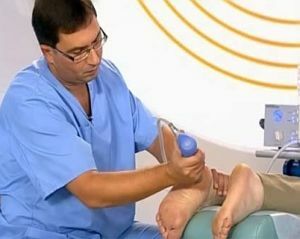 In the treatment of non-tumor diseases, the dose of radiation is 25-80 rad, which is a low level of radiation.
In the treatment of non-tumor diseases, the dose of radiation is 25-80 rad, which is a low level of radiation.
Malodose X-ray therapy is highly effective in the treatment of calcaneal spurs. The pain syndrome is fully eliminated, or significantly reduced in 70-90% of clinical cases. A third of patients experience improvement after 4 procedures.
The positive effect of the procedure can be maintained for a long time, due to the accumulation of therapeutic radiation doses in altered tissues.
Evaluation of the success of therapy occurs a few months after the start of the course of therapy. With relapse of pain, it is possible to prescribe a second course of therapy, however, only in case of a positive result of the first conducted course. Remoteness of feet from vital organs minimizes risks from exposure.
Applied X-ray therapy methods
There are two methods for treating calcaneal spur with X-ray therapy:
- Long-focus therapy. Irradiation is performed from a distance of up to 60 cm from the skin surface. Energy of radiation from 60 to 250 square meters. The rays can penetrate into the tissue more than 5 cm. The therapeutic effect is on the vessels, bones, nerve fibers. With this method, the most active effect on the pathological focus occurs. Long-focus therapy requires extreme caution in the application.
- Near-focus X-ray therapy. Irradiation occurs from a distance of 7 cm from the skin surface. Energy of radiation up to 60 square meters. The rays pass into the depths of the tissues by less than 5 cm. The treatment affects the fascia, skin, ligaments, muscles. X-rays help to relieve inflammation from the tissues. There is a slight effect on the heel spur.
Different methods use different X-ray therapy devices. As the voltage increases, the radiation level also increases, and accordingly the penetration capacity in the tissue increases.
Description of the procedure
Treatment of calcaneal spur with X-ray occurs on an outpatient basis. The number and duration of procedures is determined and prescribed by a physician as an orthopedist. X-ray therapy is used in case of ineffectiveness of conservative methods of treatment and stable pain syndrome. It is not an alternative to an operative method of treatment, rather an extreme method before surgical intervention. 
During the procedure the patient occupies a horizontal position, the leg is raised. To the heel zone, an X-ray source is fed-an X-ray tube.
One session of the procedure lasts about 10 minutes. It is recommended to carry out therapy once in 2-3 days. The full course consists of 10 sessions. The second course is possible in 2-3 months.
There is no need to be under medical supervision. If the symptoms are alleviated, the treatment should not be discontinued, and a full course of therapy should be completed. A positive result is observed in 90% of patients.
Advantages of the
method Among the advantages of the therapy:
- during the sessions, there are no painful and uncomfortable sensations;
- a short duration of the procedure;
- short course of therapy - 10 sessions can be sufficient to achieve a positive effect;
- a small number of contraindications;
- no need to stay in the hospital;
- significant anti-inflammatory, analgesic effect;
- possibility to avoid surgical intervention;
- point exposure to X-rays without affecting the surrounding areas.
Expected result
X-ray therapy does not provide for complete elimination of the calcaneal spur. The result of the therapy sessions is the disappearance of the pain syndrome. Positive effect occurs in most cases, improvement is observed after the third session.
The success of treatment depends on the degree of severity of pathology, duration of the course, age and general condition of the patient. The best result is achieved by observing the recommendations on easing the load on the legs: patients should wear orthopedic shoes, use orthopedic insoles and liners in shoes, lose weight.
If it is not possible to use orthopedic shoes, it is recommended to avoid uncomfortable shoes and too high heels.
Contraindications and Cautions
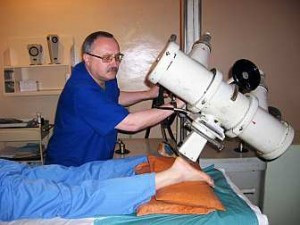 The main disadvantage of the method is the possible negative effect on the body, which can be applied by X-ray radiation. Also, the shortcomings include the lack of standardized protocols of therapy.
The main disadvantage of the method is the possible negative effect on the body, which can be applied by X-ray radiation. Also, the shortcomings include the lack of standardized protocols of therapy.
This means that there are no only accepted treatment regimens for specific clinical manifestations, therapy is appointed based on the subjective opinion of the physician. This factor may call into question the effectiveness and safety of the chosen treatment regimen.
X-ray therapy is not performed under the following conditions:
- radiation sickness, radiation damage;
- pathological conditions of blood( anemia, thrombocytopenia, leukopenia);
- stage of decompensation in diseases of the kidneys, liver, lungs, heart;
- total body exhaustion;
- general body condition;
- pregnancy;
- lactation period;
- acute stage of stomach and duodenal ulcer;
- pneumonia;
- pleurisy;
- sepsis;
- inflammation in the site of exposure.
Following the course of X-ray therapy, the following recommendations should be adhered to:
- , the time interval between X-ray therapy procedures and physiotherapy procedures should be at least 3 months;
- 10 days prior to the beginning of X-ray sessions, it is necessary to stop the use of irritating ointments, you can resume the use of ointments within a month after the end of the course;
- does not treat the skin at the site of exposure to brilliant greens and iodine;
- for one month to refuse the reception of hot baths, the use of heaters and compresses.


